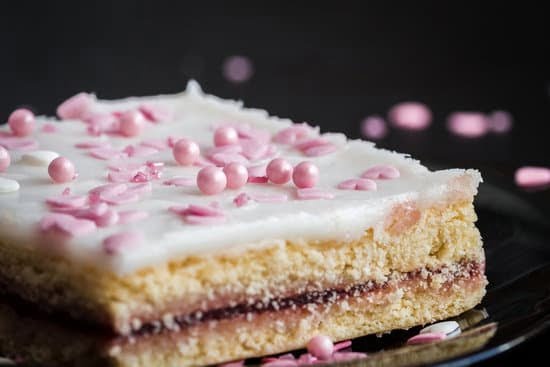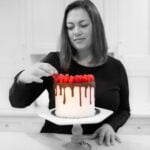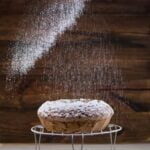Are you looking to add a touch of elegance and creativity to your cakes? In this article, we will discuss how to decorate a cake with fondant, a versatile and stunning medium that allows for endless possibilities in cake design.
Fondant has become increasingly popular in the world of cake decorating due to its smooth, polished finish and ability to be molded into intricate shapes and designs. Whether you’re a beginner or an experienced baker, mastering the art of fondant cake decorating can take your creations to the next level.
Fondant is a sugar-based paste that can be rolled out into thin sheets and draped over cakes for a flawless, professional look. It acts as a blank canvas for your imagination, allowing you to create custom designs, patterns, and textures on your cakes.
From simple and elegant wedding cakes to whimsical birthday confections, fondant offers endless opportunities for creativity. In this introductory section, we will delve into the beauty and versatility of fondant as a cake decorating medium, setting the stage for you to explore the various techniques and tips for creating stunning fondant-decorated masterpieces.
Throughout this article, we will provide comprehensive guidance on every step of the fondant decorating process. From preparing the cake for fondant application to troubleshooting common issues that may arise during decoration, we aim to equip you with the knowledge and skills needed to confidently adorn your cakes with fondant.
Whether you’re interested in learning how to color and knead fondant or want to discover decorative techniques such as embossing and creating edible flowers, this guide has got you covered. So roll up your sleeves, grab some tools and materials, because it’s time to take your baking skills to new heights with fondant.
Tools and Materials
When it comes to decorating a cake with fondant, having the right tools and materials is essential for achieving professional-looking results. Here is a comprehensive list of the essential items needed for fondant cake decorating:
1. Fondant: The star of the show, fondant comes in various colors and can be purchased pre-made or made from scratch using marshmallows or powdered sugar.
2. Rolling Pin: A non-stick rolling pin is crucial for rolling out the fondant to the perfect thickness without it sticking.
3. Fondant Smoother: This tool helps smooth out the fondant on the cake and eliminate any air bubbles or wrinkles.
4. Cutting Tools: A sharp knife or pizza cutter is necessary for trimming excess fondant and creating clean edges.
5. Embossing Tools: These tools are used to create textured patterns and designs on the fondant for added visual interest.
6. Edible Glue or Royal Icing: These act as adhesive to attach decorations, pieces of fondant, or edible embellishments to the cake.
7. Dusting Pouch: Cornstarch or powdered sugar in a dusting pouch prevents the fondant from sticking to surfaces while rolling it out.
8. Gel Food Coloring: Used to color white fondant to achieve custom shades for cake decoration.
9. Cake Decorating Turntable: This handy tool allows for easy access to all sides of the cake while applying and smoothing out the fondant.
10. Silicone Mat: Perfect for kneading and coloring fondant without it sticking to surfaces – especially helpful when creating intricate decorations such as flowers and figures.
With these essential tools and materials at your disposal, you’ll be well-equipped to embark on your journey of decorating a cake with fondant with confidence and creativity. Whether you’re a beginner or an experienced baker, having these items on hand will make the process smoother and more enjoyable as you bring your cake decorating visions to life.
Preparing the Cake
Before you can start decorating a cake with fondant, it’s crucial to properly prepare the cake to ensure a smooth and flawless surface for the fondant to adhere to. Here are some step-by-step instructions on how to prepare the cake for fondant decoration:
First, make sure that your cake is completely cooled before you begin decorating. Warm cakes can cause the fondant to become too soft and lose its shape, so it’s best to work with a cooled cake.
Next, it’s essential to level the top of the cake to create an even surface. You can use a serrated knife or a cake leveler to carefully trim off any uneven or domed areas. This will make it easier for the fondant to lay flat and prevent any bulging or wrinkling.
Once your cake is leveled, it’s time to apply a thin layer of buttercream or frosting all over the cake. This layer acts as an adhesive for the fondant and helps it stick to the cake. Make sure to spread the frosting evenly and smooth out any bumps or air bubbles.
After applying the thin layer of frosting, allow the cake to chill in the refrigerator for at least 30 minutes. This will help set the frosting and create a firmer surface for applying the fondant. By following these steps, you’ll be well on your way towards decorating a stunning cake with fondant.
Preparing your cake properly is crucial when deciding how to decorate a cake with fondant. It sets the foundation for a beautiful and professional-looking finish, ensuring that your fondant adheres smoothly and flawlessly. With these step-by-step instructions, you’ll be able to prepare your cakes like a pro and create gorgeous fondant decorations that will impress everyone who sees them.
Coloring and Kneading Fondant
When it comes to decorating a cake with fondant, achieving the perfect color is essential. Whether you are aiming for soft pastels or vibrant hues, coloring fondant can be done using gel food colors specifically designed for tinting fondant. These colors come in a wide range of shades and are highly concentrated, allowing you to achieve vivid colors without altering the consistency of the fondant.
To color fondant, start by adding a small amount of gel food color to the fondant and kneading it until the color is evenly distributed. It’s important to add the color gradually to avoid ending up with a shade darker than desired. For deeper or darker shades, allow the colored fondant to rest for several hours or overnight before using it. This will give the color time to fully develop.
Kneading Fondant:
Properly kneading fondant is crucial in achieving a smooth and pliable texture for decorating cakes. Before kneading, make sure your work surface is clean and lightly dusted with cornstarch or powdered sugar to prevent sticking. When kneading, use your palms to push the fondant away from you and then fold it over itself, repeating this motion until the fondant becomes smooth and elastic.
It’s important not to over-knead the fondant as it can cause it to become too soft and difficult to work with. If the fondant becomes too sticky during kneading, simply add a small amount of cornstarch or powdered sugar as needed to achieve the desired texture. Once properly kneaded, wrap the fondant in plastic wrap and let it rest at room temperature for at least 30 minutes before using it on your cake.
With these tips on how to properly color and knead fondant, you can now confidently proceed with decorating your cake using this versatile medium. Whether you’re going for a simple and elegant look or an elaborate design, mastering these fundamental techniques will set you up for success in creating stunning fondant-decorated cakes.
Rolling and Covering the Cake
First, ensure that the cake is properly prepared for fondant decoration. It should be levelled, crumb-coated, and chilled to ensure stability when applying the fondant. Once the cake is ready, dust your work surface with confectioner’s sugar or cornstarch to prevent the fondant from sticking.
Next, knead the fondant until it is pliable and smooth. Roll it out with a rolling pin to about 1/4 inch thickness, making sure to lift and turn the fondant as you roll to prevent it from sticking to the work surface. Measure the diameter of your cake and use this measurement plus twice the height of the cake as a guide for how large your rolled-out fondant should be.
When rolling out fondant, it’s important to work quickly but carefully to avoid drying it out. Once rolled out, carefully lift the fondant over the rolling pin and drape it over the chilled, prepared cake. Smooth the top of the fondant with a fondant smoother or your hands, then gently smooth down the sides, working from top to bottom to remove any air bubbles. Trim off any excess fondant at the base of the cake using a sharp knife.
Practice makes perfect when it comes to covering cakes with fondant, so don’t be discouraged if it doesn’t come out perfectly on your first try. With patience and perseverance, you’ll soon master this essential cake decorating skill.
| Aspect | Instructions |
|---|---|
| Prepare Cake | Level, crumb-coat, and chill before applying fondant |
| Rolling Out Fondant | Knead until pliable, roll out with rolling pin to desired thickness |
| Covering Cake | Drape rolled-out fondante over chilled cake, smooth top and sides until seamless |
Decorative Techniques
Embossing
Embossing is a popular decorative technique used to add intricate designs and patterns to a fondant-covered cake. To emboss fondant, you will need embossing tools or rolling pins with various patterns. Before covering the cake with fondant, roll out the fondant to the desired thickness. Then, gently press the embossing tool or rolling pin onto the fondant, creating an elegant design. This technique adds a sophisticated and textured look to the cake, elevating its overall appearance.
Ruffling
Ruffling is a gorgeous decorative technique that creates delicate and whimsical ruffles on the surface of the fondant. To achieve this effect, roll out thin strips of fondant and gently gather and fold them to create ruffled shapes. These ruffles can then be arranged on the cake in various patterns, adding a soft and romantic touch to the design. Ruffling is perfect for creating vintage-inspired or floral-themed cakes, allowing decorators to showcase their creativity and artistic skills.
Creating Fondant Flowers
Fondant flowers are a stunning addition to any cake design and can elevate the overall aesthetic of the dessert. With fondant, decorators can craft an array of flowers in different sizes, shapes, and colors to suit their design vision. Popular flowers created from fondant include roses, peonies, daisies, and hydrangeas.
These edible blooms can be arranged as a focal point on top of the cake or scattered throughout the design for an enchanting touch. Learning how to decorate a cake with fondant flowers opens up endless possibilities for creating visually captivating and personalized cakes.
By mastering these decorative techniques for fondant cake decorating, individuals can unleash their creativity and transform simple cakes into stunning works of art that are not only visually appealing but also delicious. Whether it’s an elegant wedding cake or a whimsical birthday confection, these techniques allow for endless creative expression when it comes to decorating cakes with fondant.
Troubleshooting Common Issues
When decorating a cake with fondant, it’s important to be aware of common issues that may arise during the decorating process and how to fix them. One of the most common problems is air bubbles forming beneath the fondant.
This can create unsightly bumps and wrinkles on the surface of the cake. To fix this issue, you can use a small pin to gently prick the air bubble and then smooth out the fondant with your hands or a fondant smoother.
Another common issue is fondant tearing or cracking while being rolled out or transferred onto the cake. This can happen if the fondant is too dry or if it has been overworked.
To prevent this problem, make sure to knead your fondant thoroughly before rolling it out, and work with it while it’s still soft and pliable. If tearing or cracking occurs, you can try using a small amount of vegetable shortening to gently patch and smooth out the affected areas.
Additionally, humidity can also cause issues when working with fondant. In high humidity environments, fondant may become sticky and difficult to manage, while in low humidity environments, it may dry out and become prone to cracking. To address these problems, you can adjust the amount of powdered sugar used when rolling out the fondant in high humidity conditions, or lightly mist the surface of the cake with water in low humidity conditions to help adhere the fondant.
| Common Issue | How to Fix |
|---|---|
| Air Bubbles | Use a pin to prick and smooth out |
| Tearing/Cracking Fondant | Knead thoroughly before rolling and patch with vegetable shortening |
| Humidity | Adjust powdered sugar in high humidity, lightly mist cake in low humidity |
Finishing Touches
Once the cake is covered in fondant and the base design is in place, it’s time to add those final touches and embellishments that will truly elevate the overall look of the decorated cake. Whether it’s adding intricate details, edging, or dimensional elements, these finishing touches can make a significant impact on the final presentation of the cake.
Here are some tips on how to add final details and embellishments to your fondant-decorated cake:
- Edging: Consider adding a decorative edge to the base of your cake. You can use fondant cutters, piping, or even edible pearls or beads to create a stunning border that adds visual interest and elegance to the design.
- Dimensional Elements: Adding dimensional elements like fondant bows, ribbons, or sculpted figures can bring a whimsical and personalized touch to your cake. These elements can be pre-made using fondant or gum paste and carefully placed on the cake for a customized look.
- Painted Details: For an artistic flair, consider using food-safe paint or edible dusts to add hand-painted details directly onto the fondant. This can include delicate florals, intricate patterns, or even metallic accents for a touch of glamour.
By paying attention to these finishing touches, you can transform a simple fondant-covered cake into an exquisite work of art that is sure to impress any event or celebration.
Remember that the key to achieving stunning finishing touches lies in patience and attention to detail. Keep experimenting with different techniques and elements until you achieve a final design that truly reflects your creativity and vision for the cake. With these tips in mind, you’ll be able to create beautifully embellished cakes that showcase both skillful craftsmanship and artistic expression.
Conclusion
In conclusion, mastering the art of decorating cakes with fondant opens up a world of creative possibilities for both amateur and professional bakers alike. Fondant’s versatility and ability to transform any cake into a work of art makes it a popular choice for special occasions such as birthdays, weddings, and anniversaries.
By following the step-by-step instructions provided in this article, you can elevate your cake decorating skills and create stunning confections that will be the centerpiece of any celebration.
The key to successful fondant cake decorating lies in proper preparation, precision, and a dash of creativity. From preparing the cake to coloring and kneading fondant, rolling it out, and applying decorative techniques, each step requires attention to detail and patience. However, with practice and dedication, anyone can learn how to decorate a cake with fondant like a pro.
So why not unleash your inner artist and try your hand at decorating cakes with fondant? Whether you’re an experienced baker looking to expand your repertoire or a novice eager to learn something new, experimenting with fondant opens up endless possibilities for expressing your creativity.
With the right tools, materials, and techniques at your disposal, you can turn an ordinary cake into an extraordinary masterpiece that will delight both the eyes and taste buds of those who behold it. Embrace the challenge, embrace the creativity, and embrace the beauty that is fondant cake decorating.
Frequently Asked Questions
How Do You Put Fondant on a Cake for Beginners?
Putting fondant on a cake for beginners may seem daunting, but it’s manageable with some practice. Start by rolling out the fondant to the desired thickness, then carefully lift and drape it over the cake. Smooth out any wrinkles and trim excess fondant.
How Do You Get Fondant to Stick to a Cake?
To get fondant to stick to a cake, you can lightly brush the surface of the cake with a simple syrup or water before placing the fondant on top. This moisture will help create a sticky surface for the fondant to adhere to.
Can You Put Fondant Straight on a Cake?
Yes, you can put fondant straight on a cake without applying anything underneath. However, if your cake has a particularly moist filling or icing, it may cause the fondant to become soggy over time. In this case, you can use a layer of buttercream as a barrier before adding the fondant.

Welcome to our cake decorating blog! My name is Destiny Flores, and I am the proud owner of a cake decorating business named Cake Karma. Our mission is to provide delicious, beautiful cakes for all occasions. We specialize in creating custom cakes that are tailored specifically to each customer’s individual needs and tastes.





